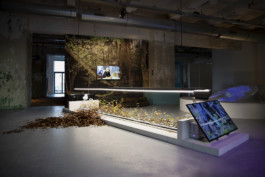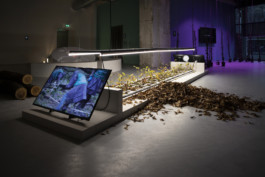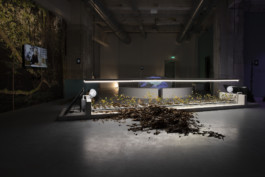






The project research focuses on how the classification of native and non-native plant species manipulates the human perspective on nature and nature management, in relation to the topic of ‘Invasive Alien Species’. A case study of American Black Cherry (Prunus Serotina Ehr.) proves how such dichotomous view has played a crucial role to transform the relationships between introduced tree species and society.
The two-channel videos ‘The Hole in the Ground – Part 1 & Part 2’, inspired by the common ways of eradicating Black Cherries by nature conservations, displays five people working in the Black Cherry forest (Oerle, The Netherlands). The recording of the eradicating process is edited according to two sequential and reverse time flows, overturning the working intentions and consequences of such actions in nature.
The installation, consisting of Black Cherry seedlings brought from the place where the scene was shot, interposes a physical distance between the two videos, thus bringing up opposite results and interpretations.
Finally, an interview with Dr. Jan Den Ouden, professor of Forest Ecology and Forest Management at Wageningen University, explains how the division between native and non-native species causes hardship in nature management and research, and why it is entangled with social-political perspectives.
How can we find ways to coexist between native and non-native species in contemporary nature, where are no more predetermined limits and plants are crossing over several continents?
MU Artspace, Eindhoven, NL, 2019
Polarities. Psychology and Politics of Being Ecological
640 X 120 X 160 CM
INTERVIEWEE
Jan Den Ouden
Professor, Forest Ecology
and Forest Management,
Wageningen University
Photo by Minji Choi




The project research focuses on how the classification of native and non-native plant species manipulates the human perspective on nature and nature management, in relation to the topic of ‘Invasive Alien Species’. A case study of American Black Cherry (Prunus Serotina Ehr.) proves how such dichotomous view has played a crucial role to transform the relationships between introduced tree species and society.
The two-channel videos ‘The Hole in the Ground – Part 1 & Part 2’, inspired by the common ways of eradicating Black Cherries by nature conservations, displays five people working in the Black Cherry forest (Oerle, The Netherlands). The recording of the eradicating process is edited according to two sequential and reverse time flows, overturning the working intentions and consequences of such actions in nature.
The installation, consisting of Black Cherry seedlings brought from the place where the scene was shot, interposes a physical distance between the two videos, thus bringing up opposite results and interpretations.
Finally, an interview with Dr. Jan Den Ouden, professor of Forest Ecology and Forest Management at Wageningen University, explains how the division between native and non-native species causes hardship in nature management and research, and why it is entangled with social-political perspectives.
How can we find ways to coexist between native and non-native species in contemporary nature, where are no more predetermined limits and plants are crossing over several continents?
MU Artspace, Eindhoven, NL, 2019
Polarities. Psychology and Politics of Being Ecological
640 X 120 X 160 CM
INTERVIEWEE
Jan Den Ouden
Professor, Forest Ecology
and Forest Management,
Wageningen University
Photo by Minji Choi
© Minji Choi 2024